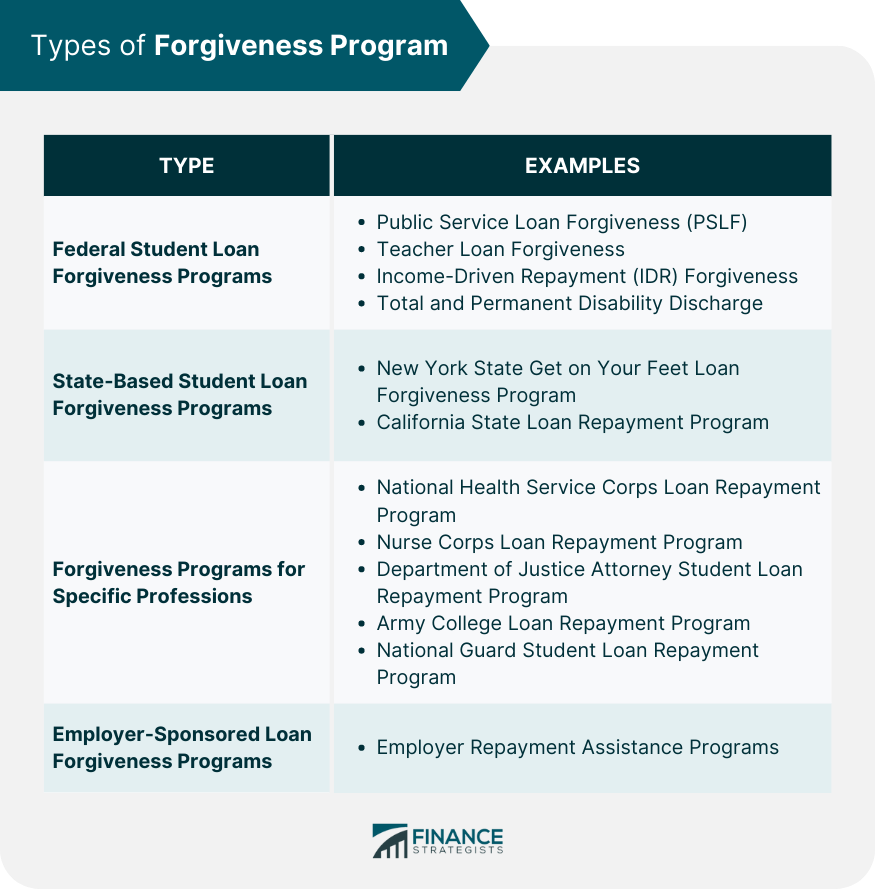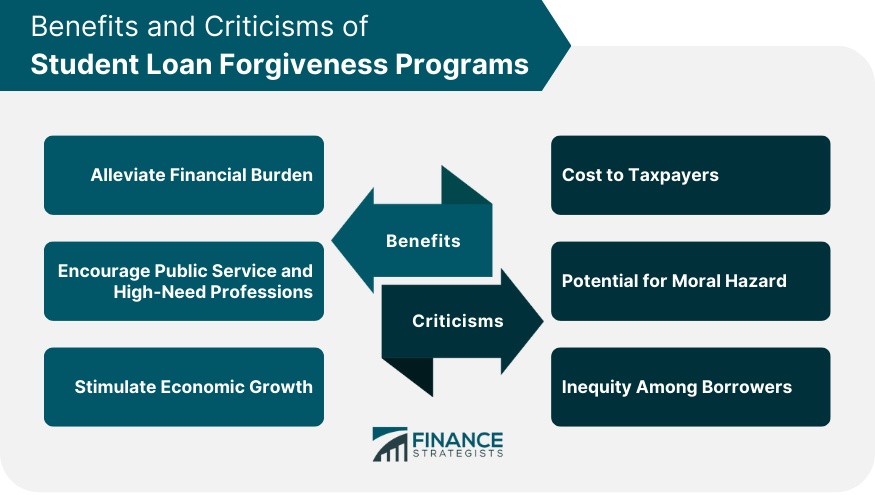Student loan forgiveness programs are initiatives that provide eligible borrowers with partial or full relief from their student loan debt. These programs are typically offered by the government or other organizations to address the burden of student loan debt and encourage careers in high-need fields or public service. Student loan debt has a significant impact on borrowers and the broader economy. High levels of debt can limit individuals' financial flexibility, hindering their ability to make key life decisions, such as buying a home or starting a family. Additionally, the burden of student loan debt can contribute to socioeconomic inequality and hinder economic growth. The primary purpose of student loan forgiveness programs is to alleviate the financial burden of student loan debt for qualifying individuals. These programs also aim to incentivize careers in public service, high-need professions, or underserved communities, ultimately benefiting society as a whole. Federal student loan forgiveness programs are initiatives offered by the U.S. government that provide debt relief for eligible borrowers. These programs typically have specific eligibility criteria and are designed to encourage public service or careers in high-need fields. PSLF is a program that forgives the remaining balance of Direct Loans after a borrower makes 120 qualifying monthly payments while working full-time for a qualifying employer, such as a government or nonprofit organization. The goal of PSLF is to encourage individuals to pursue careers in public service. Teacher Loan Forgiveness is a program that provides debt relief to eligible teachers who have completed five consecutive years of service in a low-income school or educational service agency. This program aims to attract and retain high-quality teachers in underprivileged schools. IDR Forgiveness is a program that forgives the remaining loan balance after a borrower makes qualifying payments under an income-driven repayment plan for a specified period, typically 20 or 25 years. This program aims to make student loan repayment more manageable for borrowers with limited income. Total and Permanent Disability Discharge is a program that discharges federal student loans for borrowers who are determined to be totally and permanently disabled. This program recognizes the financial hardship faced by individuals with severe disabilities and provides them with debt relief. State-based student loan forgiveness programs are initiatives offered by individual states to provide student loan debt relief for eligible residents. These programs often target specific professions or industries to address workforce shortages or encourage economic development. Each state may have its own student loan forgiveness programs with unique eligibility requirements, often targeting specific professions or industries. Borrowers should research their state's programs and criteria to determine if they qualify for any available opportunities. Examples of state-based forgiveness programs include the New York State Get on Your Feet Loan Forgiveness Program, which provides relief for recent graduates. Another example is the California State Loan Repayment Program, which assists healthcare professionals working in underserved communities. Some student loan forgiveness programs target specific professions to encourage individuals to pursue careers in high-need fields or underserved areas. These programs may be offered by federal or state governments or by professional organizations. Health professional forgiveness programs aim to attract and retain healthcare workers in underserved areas or high-need specialties. Examples include the National Health Service Corps Loan Repayment Program and the Nurse Corps Loan Repayment Program. Legal professional forgiveness programs incentivize attorneys to work in public service roles or underserved communities by providing student loan debt relief. Examples include the Department of Justice Attorney Student Loan Repayment Program and state-specific programs for public defenders and prosecutors. Military service member forgiveness programs provide student loan debt relief to eligible individuals who serve in the armed forces. Examples include the Army College Loan Repayment Program and the National Guard Student Loan Repayment Program, which aim to attract and retain military personnel. Employer-sponsored loan forgiveness programs are initiatives offered by companies to help employees repay their student loans. These programs can be a valuable employee benefit and may help attract and retain talent. Employer repayment assistance programs provide financial contributions towards an employee's student loan debt, often as a monthly or annual benefit. These programs can help employees pay down their loans faster and reduce their overall financial burden. Employer-sponsored loan forgiveness programs may have tax implications for both the employer and the employee. While employer contributions to student loan repayments are generally considered taxable income for the employee, recent legislation has temporarily allowed for tax-free contributions under certain conditions. General eligibility requirements for student loan forgiveness programs typically include factors such as loan type, employment in a qualifying profession or organization, and meeting specific service or repayment obligations. Borrowers should carefully review program guidelines to determine their eligibility. The application process for student loan forgiveness programs typically involves submitting an application form and providing supporting documentation to demonstrate eligibility. This may include employment records, proof of loan status, and other relevant information. Borrowers pursuing student loan forgiveness should monitor their progress toward meeting program requirements, such as tracking qualifying payments or service time. Staying informed and proactive can help ensure the successful completion of the forgiveness program. Student loan forgiveness programs can significantly reduce or eliminate the financial burden of student loan debt for eligible borrowers, providing much-needed relief and improving their overall financial well-being. By providing debt relief, student loan forgiveness programs incentivize careers in public service and high-need professions, addressing workforce shortages and benefiting underserved communities. Forgiving student loan debt can have positive macroeconomic effects, such as increasing consumer spending and stimulating economic growth by freeing up disposable income for borrowers. Student loan forgiveness programs can be expensive for taxpayers, as the cost of forgiven loans is often borne by the government. This has led to concerns about the long-term sustainability of these programs. Critics argues that student loan forgiveness programs can create moral hazard by encouraging excessive borrowing, as borrowers may assume their debt will ultimately be forgiven. Student loan forgiveness programs may disproportionately benefit higher-income borrowers with larger debt balances, leading to concerns about fairness and equity among borrowers. Student loan forgiveness programs are initiatives that provide partial or full relief from student loan debt for eligible borrowers. These programs aim to alleviate the financial burden of student loan debt, incentivize careers in public service and high-need fields, and stimulate economic growth. Federal student loan forgiveness programs include Public Service Loan Forgiveness, Teacher Loan Forgiveness, Income-Driven Repayment Forgiveness, and Total and Permanent Disability Discharge. State-based forgiveness programs target specific professions or industries, while forgiveness programs for specific professions encourage individuals to pursue careers in high-need fields or underserved areas. Employer-sponsored loan forgiveness programs are initiatives offered by companies to help employees repay their student loans. Eligibility criteria, application processes, and documentation requirements vary by program. While student loan forgiveness programs have benefits such as alleviating financial burden, encouraging public service and high-need professions, and stimulating economic growth, criticisms include cost to taxpayers, potential for moral hazard, and inequity among borrowers.What Is Student Loan Forgiveness Programs?
Types of Student Loan Forgiveness Programs
Federal Student Loan Forgiveness Programs
Public Service Loan Forgiveness (PSLF)
Teacher Loan Forgiveness
Income-Driven Repayment (IDR) Forgiveness
Total and Permanent Disability Discharge
State-Based Student Loan Forgiveness Programs
State-Specific Programs and Eligibility Requirements
Examples of State-Based Programs
Forgiveness Programs for Specific Professions
Health Professionals
Legal Professionals
Military Service Members
Employer-Sponsored Loan Forgiveness Programs
Employer Repayment Assistance Programs
Tax Implications and Considerations

Eligibility Criteria and Application Process for Student Loan Forgiveness Programs
General Eligibility Requirements
Application Process and Documentation
Monitoring Progress Towards Forgiveness
Benefits of Student Loan Forgiveness Programs
Alleviating Financial Burden
Encouraging Public Service and High-Need Professions
Stimulating Economic Growth
Criticisms of Student Loan Forgiveness Programs
Cost to Taxpayers
Potential for Moral Hazard
Inequity Among Borrowers

Final Thoughts
Student Loan Forgiveness Programs FAQs
Student loan forgiveness programs can be categorized into federal, state-based, employer-sponsored, and profession-specific programs. These programs aim to provide relief from student loan debt for eligible borrowers, often targeting public service, high-need professions, or underserved communities.
To determine eligibility for a student loan forgiveness program, borrowers should carefully review the program's guidelines, including criteria related to loan type, employment, and service or repayment obligations. It may also be helpful to consult a financial advisor for personalized guidance.
The application process typically involves submitting an application form and providing supporting documentation to demonstrate eligibility, such as employment records, proof of loan status, and other relevant information. Each program may have its own specific application process and deadlines.
Alternative approaches to addressing student loan debt include income-driven repayment plans, refinancing options, and exploring broader higher education reforms, such as reducing tuition costs or increasing access to affordable education.
Staying informed about student loan forgiveness programs involves regularly checking program websites, monitoring news and policy updates, and potentially seeking guidance from a financial advisor who specializes in student loans. This proactive approach can help borrowers stay up-to-date on their options and make well-informed decisions about their student loan debt.
True Tamplin is a published author, public speaker, CEO of UpDigital, and founder of Finance Strategists.
True is a Certified Educator in Personal Finance (CEPF®), author of The Handy Financial Ratios Guide, a member of the Society for Advancing Business Editing and Writing, contributes to his financial education site, Finance Strategists, and has spoken to various financial communities such as the CFA Institute, as well as university students like his Alma mater, Biola University, where he received a bachelor of science in business and data analytics.
To learn more about True, visit his personal website or view his author profiles on Amazon, Nasdaq and Forbes.











